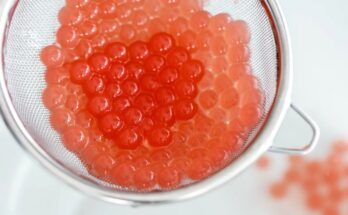Omurice Recipe: Omurice, short for “omelette rice,” is a classic fusion dish that brings together Japanese flavors with Western influence. At its core, it’s a delicious mound of savory fried rice wrapped in a soft, silky omelette—often topped with ketchup or a demi-glace sauce. Think of it as Japan’s version of comfort food, where simplicity meets flavor in every bite. It’s incredibly popular among kids and adults alike, often seen in home kitchens, bento boxes, and café menus across Japan.
The charm of omurice lies in its versatility. Whether you want to stick to a traditional chicken-and-ketchup rice combo or jazz it up with bacon, mushrooms, or cheese, the base structure allows for endless creativity. It’s also a fantastic way to use up leftover rice, making it an economical and practical dish for any day of the week. And the best part? You don’t need to be a trained chef to nail this recipe. If you can make scrambled eggs and stir-fry rice, you’re halfway there.
A Glimpse Into the Origin of Omurice
The roots of omurice go back to the early 1900s during the Meiji Era in Japan, a time when Western cuisine began influencing Japanese culinary traditions. It is believed to have originated in a Western-style restaurant in Tokyo called Renga-tei. The idea was to serve a meal that looked Western but still appealed to Japanese palates. Enter omurice—a playful combination of Western-style omelette and Japanese-style fried rice.
Over the years, this dish evolved from a simple rice-and-egg combo to a symbol of home-style cooking in Japan. Its nostalgic value runs deep; many Japanese adults fondly remember their parents or grandparents making omurice during their childhood. Today, it’s enjoyed globally and often features in anime and J-dramas, which only adds to its popularity. It’s proof that good food has no boundaries and can tell stories across generations.
Why You’ll Love Making Omurice at Home
Cooking omurice at home is not just about replicating a recipe—it’s about the experience. It’s quick, affordable, and doesn’t require fancy ingredients. Plus, it’s perfect for all skill levels. Whether you’re a beginner cook or a home chef looking to try something new, omurice offers a satisfying reward for your efforts.
Another perk is how customizable it is. Not a fan of chicken? Try it with beef, tofu, or even shrimp. Want it spicy? Add a kick with chili paste or sriracha. You can make it as healthy or as indulgent as you like. And let’s be real—the wow factor when you slice the omelette and it cascades over the rice is Instagram gold.
Ingredients You’ll Need
Essential Ingredients for the Rice
Here’s a list of what you need for that savory, flavorful fried rice base:
- 2 cups of cooked white rice (preferably cold, leftover rice works best)
- 1/2 cup of diced chicken breast or thigh
- 1/4 cup of finely chopped onion
- 1/4 cup of chopped carrots
- 2 tablespoons of ketchup
- 1 tablespoon of soy sauce
- 1 tablespoon of vegetable oil
- Salt and pepper to taste
The foundation of great omurice starts with the rice. Cold rice works best because it prevents clumping and ensures each grain stays separate. The ketchup might seem like an odd ingredient at first, but it’s what gives the dish that sweet, tangy base. Combined with soy sauce, it adds umami depth you’d never expect from such simple components.
What You’ll Need for the Fluffy Omelette
For the eggy wrap that hugs your rice perfectly, you’ll need:
- 2 large eggs
- 1 tablespoon of milk or cream (optional for creaminess)
- Pinch of salt
- 1/2 tablespoon of butter or oil
The trick here is to whisk the eggs just enough to mix the whites and yolks without over-beating. Adding milk gives the omelette a luxurious texture, while butter imparts that lovely golden-brown sheen. The goal is a soft, custardy layer that just barely sets before folding over your rice.
Optional Add-ins and Toppings
Feel like going the extra mile? Here are some tasty additions:
- Peas, corn, or bell peppers
- Cheese (mozzarella or cheddar melts beautifully)
- Mushrooms
- Bacon or ham instead of chicken
- Worcestershire sauce for added zing
- Fresh parsley or chives for garnish
- Ketchup or demi-glace sauce for the finishing touch
Toppings and extras are your playground. You can tailor this dish to suit dietary needs, taste preferences, or even just to clean out your fridge. No rules—just deliciousness.
Tools You Need for Cooking Omurice
Must-Have Kitchen Tools
Don’t worry—making omurice doesn’t require any fancy gear. Here’s what you need:
- Non-stick frying pan (medium size is perfect)
- Wooden spoon or silicone spatula
- Mixing bowls for eggs and ingredients
- Cutting board and knife
- Measuring spoons
A good non-stick pan is crucial. It ensures the omelette doesn’t stick and makes flipping or folding much easier. A silicone spatula gives you better control over the egg without scratching the pan. Keeping everything prepped and within reach will also make the whole process smoother.
Pro Tips for Cooking Like a Pro
Want to elevate your omurice game? Keep these pro tips in mind:
- Use cold rice for better texture and separation.
- Cook the rice filling before starting on the omelette to prevent overcooking.
- Use medium heat—high heat can overcook the egg too fast.
- Practice the classic omelette flip or try the “omusoboro” (scrambled egg) version if you’re new.
Once you get the hang of it, you’ll be whipping up omurice like a Japanese café chef.
Step-by-Step Guide to Making Omurice
Step 1 – Cook the Chicken Fried Rice
Alright, let’s kick things off with the star of the show—the chicken fried rice. This savory, ketchup-infused rice base is what gives omurice its signature flavor. First things first: make sure your rice is cold. If you’re using freshly cooked rice, spread it out on a plate and let it cool in the fridge for about 30 minutes. This helps keep the grains from sticking together and gives the dish that perfect fried rice texture.
Start by heating a tablespoon of vegetable oil in a pan over medium heat. Toss in your diced onions and carrots. Sauté them until they begin to soften and turn slightly golden. This step builds a beautiful flavor base. Next, add in the diced chicken. Season with a little salt and pepper and cook until the meat is no longer pink.
Now comes the fun part—adding in the rice. Break up any clumps with your spatula and stir-fry everything together so the flavors mix evenly. Once the rice is heated through, drizzle in your ketchup and a splash of soy sauce. Stir well to coat the rice evenly. Don’t worry if it looks a little red—this is exactly what you want. That tangy-sweetness from the ketchup combined with the savory soy sauce brings a comforting, almost nostalgic flavor to the dish.
Once everything is well mixed and nicely fried, taste it. Need more ketchup? A pinch more salt? Customize it how you like. When you’re happy with the flavor, set the rice aside in a bowl and cover it to keep warm.
Step 2 – Prepare the Omelette
This is the part where people get a little nervous—but don’t worry! Making the perfect omelette for omurice is easier than it looks, especially if you keep things simple and follow a few key tips.
Crack two large eggs into a bowl and add a pinch of salt and a tablespoon of milk or cream if you’re feeling fancy. Whisk gently until the yolks and whites are combined. You want a nice, uniform mixture without overdoing it—just a few strokes with a fork or chopsticks will do.
Heat a clean non-stick skillet over medium-low heat and add half a tablespoon of butter or oil. Once it’s melted and slightly bubbling, pour in the egg mixture. Now here’s the secret: don’t touch it right away. Let the eggs start to set slightly around the edges. Then gently swirl the pan to help the uncooked egg reach the edges and cook evenly.
As the omelette sets, use a spatula to gently lift the sides and let any uncooked egg run underneath. You’re not looking for a firm, fully cooked egg here—think soft, slightly runny, and tender. When it’s mostly set but still a little glossy in the center, it’s ready to go. If you’re feeling bold, try the Japanese method of rolling the egg into a soft, pillow-like log using a spatula or chopsticks.
Step 3 – Assemble the Omurice
This is where everything comes together—and trust me, it’s super satisfying. Start by placing your freshly cooked chicken rice in the center of a clean plate or bowl. You can shape it into an oval using a spoon or small bowl if you want to get fancy. Some people even pack the rice into a cup and flip it onto the plate for a café-style presentation.
Now gently slide or fold your omelette over the rice. If you’re going for the classic “cover” style, just lay the omelette flat on top of the rice. But if you want that iconic Japanese “tornado” or soft-flip style, make a small slit down the center of the omelette with a knife or spatula. The egg will open up and cascade over the rice like a fluffy waterfall—so satisfying to watch.
Not quite perfect? No worries. Omurice is a forgiving dish. Even if your omelette breaks or doesn’t flip perfectly, it’ll still taste amazing. The important part is that the rice is hot, the egg is soft, and you had fun making it.
Step 4 – Add the Sauce and Garnish
Time for the finishing touch—the sauce. While ketchup is the most traditional (and still totally legit), you can level up your omurice with a variety of toppings. Here are a few crowd-pleasing ideas:
- Classic ketchup – Drizzle in a zigzag over the top
- Demi-glace sauce – Rich and savory, like a beef gravy with red wine
- White sauce – Creamy béchamel for a European twist
- Curry sauce – A bold Japanese curry adds amazing depth
Don’t forget the garnishes. A sprinkle of chopped parsley or chives adds a nice pop of color. You can even serve it with a side of pickled vegetables or a green salad for contrast.
Want to make it Instagram-worthy? Add a tiny dollop of ketchup to make a heart or smiley face on top. Your omurice just became edible art.
Tips and Tricks for Perfect Omurice Every Time
How to Get That Restaurant-Style Fluffy Egg
Mastering the egg is what separates a decent omurice from an unforgettable one. If you want that pillowy, custard-like texture that you see in viral videos and fancy Japanese cafés, here are the key moves:
- Use fresh eggs – They whip up better and cook more evenly
- Whisk gently – Overbeating makes the texture rubbery
- Control the heat – Medium-low is your friend
- Butter is better – It adds flavor and helps the eggs cook more evenly
- Don’t overcook – The egg should be just set, with a soft interior
Some chefs use a “scramble-and-roll” method where they scramble the egg slightly in the pan and then gently shape it into a log. Others go for the “tornado omurice,” which involves using chopsticks to twist the egg as it cooks. It takes practice, but once you get it, you’ll feel like a kitchen wizard.
Common Mistakes to Avoid
Even though omurice is simple at heart, a few common missteps can throw off your results. Here’s what to look out for:
- Using hot rice – This causes the rice to steam and clump up
- Overloading with sauce – A little goes a long way; too much can overpower
- Overcooking the egg – This turns it rubbery and dry
- Not prepping ingredients ahead – This dish comes together quickly, so prep is key
- Using too much filling – Makes folding the omelette tricky
Treat the dish with a bit of care, and it’ll reward you with comfort in every bite.
FAQs about Omurice Recipe
What is Omurice?
Omurice is a popular fusion dish from Japan that combines omelette and rice. It typically consists of ketchup-flavored fried rice wrapped in a thin layer of egg, often topped with more ketchup or a demi-glace sauce.
What ingredients do I need for Omurice?
To make Omurice, you’ll need cooked rice, chicken (or another protein like shrimp), onion, mixed vegetables (such as peas and carrots), ketchup, eggs, salt, pepper, and oil or butter for cooking.
How do I make the rice for Omurice?
Start by frying chopped onions and protein in a bit of oil until cooked. Add the mixed vegetables and cook until they’re tender. Mix in the cooked rice and ketchup, and stir-fry everything together until well combined and heated through.
How do I wrap the rice with the egg?
Beat the eggs with a pinch of salt. In a non-stick pan, add a small amount of oil and pour in the eggs to create a thin omelette. Before the egg fully sets, place a portion of fried rice in the center and fold the omelette around the rice using a spatula.
Can I make Omurice without ketchup?
Yes! While ketchup is traditional, you can substitute it with tomato sauce or a mix of soy sauce and a little sugar for a different flavor profile. Some variations also use a creamy white sauce or curry.
Is Omurice suitable for vegetarians?
Absolutely! Just replace the chicken with tofu or more vegetables, and check that your ketchup or sauces do not contain any animal products.
How can I store leftover Omurice?
Omurice is best enjoyed fresh, but you can store leftovers in the refrigerator for up to 2 days. Reheat it in a microwave or skillet until it’s thoroughly warmed.
Can I add other ingredients to Omurice?
Yes, Omurice is highly customizable. Feel free to add mushrooms, bell peppers, or any other preferred veggies. You can also experiment with different sauces like sriracha or mayonnaise for a unique twist.
Conclusion
There’s also something incredibly rewarding about the process. From the rhythmic chopping of vegetables to the satisfying sizzle of rice in the pan and the final reveal of the fluffy omelette cascading over the rice, it’s an experience that brings joy from stove to plate. And let’s not forget the look on someone’s face when you serve them a beautiful, golden omurice topped with their name in ketchup—that’s pure magic.
Whether you’re recreating your favorite anime food scene or just want a comforting, home-cooked meal, omurice is the answer. So grab your spatula, whip out that frying pan, and give this Japanese classic a try. You’ll be hooked after the first bite.



